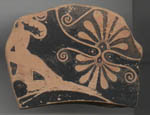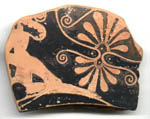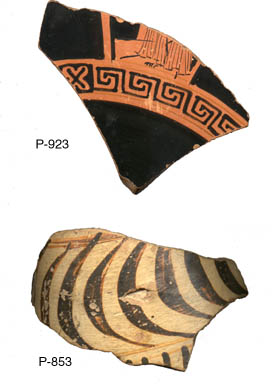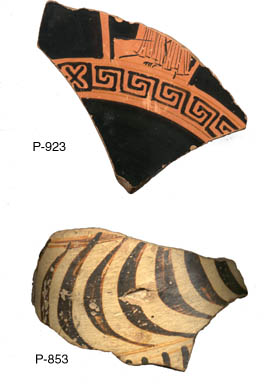
|
|
 |
|
Who needs film? Of course, all archaeologists need film, but they may no longer need it for sherds or for images intended for electronic distribution. Digital cameras and scanners may cut into Kodakís place in the hearts of archaeologists.
Digital cameras have been on the market for a few years now, and every year they get better. Resolution improves; ease-of-use improves; color fidelity improves; most important, the prices plummet. The latest round of new cameras includes sub-$1,000 models that produce images with 1600 pixels by 1200 pixels, nearly 2 million total pixels. (Pixels are the discrete dots that make up a digital image; there are only about three-quarters of a million on most so-called high-resolution computer monitors).
Using these cameras to take photographs in the field or in museums is becoming more common as quality improves and prices decline, and scholars should seriously consider using digital cameras in place of or in addition to film cameras. The advantages include ultimate cost (no film to pay for - less expensive disk space instead - and no per-photo cost at all for images not kept) and immediate quality checking. Poor images can be discarded and re-taken on the spot. Of course, the images are ready for electronic distribution immediately and can be copied over and over again with no loss of quality. Disadvantages remain as well - initial camera costs are still high, high-contrast lighting causes problems, batteries do not last long, interchangeable lenses are not available for the affordable models, and archiving is required. In addition, there is the inevitable fact about anything associated with computing; there will be better and less expensive cameras next week/month/year.
Perseus Project staff photographer Maria Daniels has begun to use digital cameras to take some photographs, and images have been mounted on the Web for inspection at http://www.perseus.tufts.edu/Pub/digital.html. (Ms. Daniels supplied information for this article, and she arranged for the images to be put up on the Perseus Web site for examination. Her assistance is greatly appreciated on both counts.) On the Perseus Web page are two images, one taken of the Pantheon in Rome with the Nikon E3 (Nikonís professional digital camera, which uses standard Nikon 35 mm. camera lenses), the other taken of a coin with a Kodak DCS460. (Although the DCS460 is a Kodak product, the camera is actually a modified Nikon. Interchangeable Nikon 35 mm. camera lenses may be used on this camera as well.) As is pointed out on the Perseus page, the images are intended for use on computer monitors, not the printed page.
The Nikon E3 is used for outdoor work by Ms. Daniels. The much more expensive Kodak DCS460 is used in safer indoor settings. Comparisons of these cameras and one of the latest sub-$1,000 models are in Table 1.
| Digital Camera Resolutions and File Sizes | |||
|---|---|---|---|
| Camera | camera resolution | file size | pixels |
| Kodak® DCS460 | 2036 x 3060 | 18 MB | 6,230,160 |
| Nikon® Coolpix 950 | 1600 x 1200 | 8 MB | 1,920,000 |
| Nikon E3 | 1280 x 1000 | 2.5 MB | 1,280,000 |
| Camera resolution: full-image resolution (numbers from company Web sites). File size: uncompressed file size (numbers from Web site except for Coolpix 950, which was not provided and had to be estimated). The file sizes are not directly comparable, because the cameras store different color depths. | |||
| Scanner Resolutions and File Sizes | |||
| Scanner resolution | time (min:sec) | file size | pixels |
| 1200 d.p.i. | 36:00 | 704 MB | 134,640,000 |
| 600 d.p.i. | 7:00 | 176 MB | 33,660,000 |
| 300 d.p.i. | 1:40 | 44 MB | 8,415,000 |
| 150 d.p.i. | 0:45 | 11 MB | 2,103,750 |
| Time: the time required to complete a scan of the objects in Figure 1 and then save the resulting file (of about three-quarters the size shown in the column labeled "file size"). File size: size of the file in PhotoShop format with no adjustments, assuming an 8 1/2 x 11" area had been scanned. Pixels: the total number of pixels in such an 8 1/2 x 11 scan. |
The Web images should appear to be roughly equal in quality since they have been reduced to fit on a computer screen. Each of the Web images, however, is linked to a copy of the original full-sized image that can be downloaded for inspection. A substantial difference exists between the two full-sized images. Since the coin was shot with a much higher-resolution camera, that image can be enlarged much more, and the image is truly stunning at maximum enlargement.
These images were taken for use in the Perseus project by Ms. Daniels. They will become part of the core Perseus data. In the meantime, they provide good examples of the current state of the art, and they show that the state of the art is very good indeed.
A less mobile but also less expensive alternative for making digital images is to use a scanner. In a discussion on an Internet list for those interested in glass (glass-list@ic.ac.uk) CSA administrative assistant Susan Jones noted a comment about making good images of glass fragments with a computer scanner. She suggested that CSA try to scan pottery fragments in the same way, and that seemed a good idea. Four fragments from the Bryn Mawr College study collection were borrowed for the experiment, and the preliminary results were very encouraging.
As the experiment was about to begin, Florida State University Professor Nancy de Grummond arrived in Philadelphia for an AIA lecture. Ms. de Grummond said she had scanned sherds at her site (Cetamura, Italy) and found the results to be excellent. That helped spur CSA to action.
A centimeter scale was created for inclusion in the scans, and a photographic color bar and a photographic gray scale were selected for inclusion as well. Then the four sherds, with targets (color bar, gray scale, and cm. scale), were arranged and scanned multiple times at the 36-bit color setting and at each of four levels of resolution (1200, 600, 300, and 150 dots per inch - d.p.i. hereafter). A standard office scanner, the UMAX® 1220S, was used. To save time, the higher resolution scans in the later experiments were made of only two sherds and did not include the targets. It became clear that the automatic settings of the scanner performed better when the targets were not included; so the two sherds were later scanned again at the lowest resolution but without the targets.
Some simple comparisons of the settings and files sizes may be instructive, see Table 1.
The sherds in the experiment were selected to provide both relatively flat and steeply curved examples, on the assumption that the curved samples would create some problems with focus on the portions farthest from the glass surface of the scanner. Sherds with different colors were also chosen intentionally.

Fig. 1 - Sherds from the Bryn Mawr College study collection with gray scale, color bar and cm. scale. Sherds were scanned at 150 dots per inch.
Of the two curved sherds, P-853 provided the more serious potential problem. The part of the sherd farthest from the glass surface of the scanner was more than 3 cm. away from the glass. Nonetheless, both the part of the sherd actually lying on the scanner and the part farthest from the glass are sharp. Depth of field is not a problem.
None of the sherds shows any real sense of three-dimensionality, because there is no shading. Creating the necessary shading requires control over the light source(s), an impossibility with scanners.
After the scans were complete, each image was altered (using PhotoShop®) by the addition of labels indicating the individual sherd numbers. The files were also changed to 8 bits of color per channel (to permit editing in PhotoShop). Finally, the background was cleaned up and made completely white. (Creating a white background was more difficult than expected. The first scans had shadows on the background that were very strong near the edges of the sherds and therefore difficult to separate from the objects themselves, even using the automated processes provided by PhotoShop. For the second set of scans a colored paper background was used, on the assumption that the color would make it easier to separate the background from the objects. The shadows near the edges of the objects were still too strong. Finally, the lid of the scanner was raised so that it did not rest on the objects. That reduced the intensity of the shadows and made it possible to eliminate them around the sherds more easily. It darkened the background generally, though, making lightening it all the more necessary. The first scans were best if some shadows could be accepted; the last were necessary if the background had to be white. See Figure 2.)
 |
 |
Fig. 2 ó Parts of two scans showing results of changing the position of the scanner lid (lid raised on left, resting on sherds on right). The intensity of the shadow beneath the sherd on the right prevented automatic separation of shadow from sherd, but the image is preferable if the background need not be white.
The color bars and the gray scale could be scanned independently and pasted into any image of the sherds, assuming that the characteristics of the scanner would not change from scan to scan. The cm. scale could be scanned separately without concern. In fact, with nothing to hold it flat, it did not scan well with the scanner lid raised; so it was scanned separately and pasted into the images of the sherds. Of course, the point of including the color bars and gray scale was to permit users to adjust printing or monitor characteristics to produce colors or gray tones to match the known color and gray values of the targets. The cm. scale is a familiar inclusion to indicate size.
Uses of digital images on paper and on screen are quite different. Resolution on screen is limited by display technology and is not very high. Printing technology, however, makes more qualitative differences possible for paper output, and very high-resolution images can be printed. Therefore, different versions of the images were prepared for the paper and Web versions of the Newsletter. (The inexpensive printing processes used for the paper version of the Newsletter can provide a guide, but higher-quality printing processes may produce very different results and/or require different levels of resolution.)
Gray-scale versions of the files were produced for use in the paper Newsletter. Included are a version of the lowest resolution image without the color bar but with the gray scale and the cm. scale (Figure 1) and an image of two sherds scanned at each level of resolution (Figures 3 through 6). The lowest-resolution image in the last group is not simply a cropped version of Figure 1; it is a separate scan, the one made without the targets. Figures 1 and 3 through 6 have been reproduced with the sherds at 1:1 scale so that the effects of scanning resolution on print quality can be properly judged. Figure 2 shows a small portion of two unretouched low-resolution scans, one with the lid resting on the sherds and one with the lid raised.
A two-times enlargement of the low-resolution scan in Figure 2 is acceptable except that the sherd edges (where the sherds meet the white background) are not sharp. That is a result of the manipulation of the image to lighten the background, not the scanning. Figure 7 shows a small portion of each of two twice-life-sized versions of the scan, the lowest- and highest-resolution scans, to illustrate quality and the effect on the edges of lightening the background. A four-times enlargement of the highest resolution scan has been included as Figure 8 to illustrate the quality available from a high-resolution scan.
| Comparison of Scanning Resolutions. | |
|---|---|

at 150 dots per inch. |

at 300 dots per inch. |

at 600 dots per inch. |

at 1200 dots per inch. |
The electronic version of this article (http://csa.brynmawr.edu /web1/nls9903.html) includes different images. All are in color, and the color bars and cm. scale are included in the one large image. Each image has been stored as a moderately compressed (jpeg) file and sized so as to produce equal reproduction ratios; as a result, there should be no differences between and among the images in terms of quality, except for the lower quality of the full-sized image with targets. Six images of only two sherds are shown for comparison purposes, one retouched version from each scanning resolution (figs. 3 - 6), one unretouched version from a scan with the lid resting on the sherds (fig. 2), and one unretouched version from a scan with the lid raised (fig. 2). A detail of a small portion of sherd P-853 shows what can be done with high-resolution scans (fig. 8); the same area of the sherd is shown in each of four images - one showing each of the four levels of resolution at maximum size (one pixel on the monitor for each pixel in the file). Each of those images includes a portion of the edge of the sherd to show the effect of lightening the background. (The Web page does not contain a version of Figure 7 - ed.)

If the scans are meant to be used only on computer screens, the lowest level of resolution seems quite adequate. If they are to be printed, that may also be the case, but edge clean-up will create difficulties. In general each step up in resolution seems to have improved the results of cleaning up the background. Apparent sharpness is quite consistent.
There are some obvious problems with scanning, however. All objects must be placed on the scanner; so maximum object size is limited. The only adjustments that can be made are scanning resolution, the number of colors, and the settings for color, contrast, and the like. Lighting cannot be adjusted to produce either background effects or shading on the objects. The lighting deficiencies are very problematic; either unattractive backgrounds must be tolerated or time must be spent altering the background. If backgrounds are to be cleaned, there is the additional problem that higher resolution scans may be required for good results.
It is also clear that scanner settings are important. That is not a problem in terms of ultimate quality, but it does mean that care is required. Scanning is not a completely automatic process.
Comparisons of digital cameras and scanners are complex. Of course, scanners are useful only for small objects, nothing larger than the plate of the scanner (up to letter- or legal-sized paper for inexpensive scanners). Inexpensive scanners are quite slow at high resolutions, and that must be considered as well. Digital cameras, on the other hand, require little more time than film cameras. Digital cameras also permit the usual photographic control of lighting, position, reproduction ratio, and the like.
Comparing quality requires considering resolution as well, and that is more complicated than may be obvious. Scanners can create images with more pixels, but the total number of pixels in the image is not the real question. The real question is the number of pixels devoted to the object.
Scanning resolution does relate pixels to objects. The object on the machine is scanned at the specified scanning resolution. It does not matter how large the object is; all of it is scanned at the same resolution.
Digital camera resolution is quite different. Resolution is measured in terms of the number of pixels in the image, regardless of the size of the object photographed. Thus, the same camera photographing the Acropolis and a coin would produce two images of equal resolution in this photographic sense; the number of pixels devoted to the Acropolis in one image would equal the number devoted to the coin in the other. That, of course, is the nature of photography, but the resolution in terms of the objects photographed is very different in those two cases.
Consider making a digital image of a coin. Using a camera and an appropriate lens, it is possible to use nearly the entire image area for the coin. Thus, using the Perseus Projectís Kodak DCS460 camera, a coin one inch in diameter might easily have about 2 million pixels devoted to the coin itself. Using the Nikon E3, the number of pixels would be no more than about 750,000. Of course, either of those cameras could be used to take detailed views of the coin and to devote all the pixels to a small portion of the whole. By the same token, each camera could be used to photograph a group of coins, reducing the number of pixels devoted to any one coin - and reducing the resolution in terms of that coin.
Scanning the coin is different. One cannot fill the image area with the coin, and scanning many at once does not change the resolution in terms of the coin. One simply sets the resolution. In this case, the same coin, scanned, would have about 1,100,000 pixels devoted to it at 1200 d.p.i. whether scanned alone or in a group of twenty. (Even higher-resolution scanners exist, but they are too expensive for these duties.)
To judge scanners and digital cameras, then, one must bear in mind the relationship of resolution to object, not total resolution. The coin is an extreme example, but it is instructive.
Consider now another example - several sherds laid out together for photography. A digital photograph might well include about the same area as the scanner - roughly the size of a piece of typing paper. What is the resolution here, the resolution relative to the sherds? The cameras devote all their pixels to the area being photographed; so the resolution in terms of the object might then range between about 240 d.p.i. for the Kodak camera and 120 d.p.i. for the Nikon E3. The scanner, on the other hand, must scan everything at the resolution selected.
Quality - in terms of scanning resolution - thus depends on more than the equipment used. The way a camera is used is equally important. In the final analysis, not surprisingly, the digital camera has some advantages and the scanner has others.
For documentation of sherds and other fragmentary finds that are unlikely to be published (except perhaps electronically), scanning seems a good choice. The costs are low, and there are relatively few variables to worry about. For those more important objects, again assuming only electronic publication, digital cameras allow more control and produce better images.
Each of the technologies provides images of more than adequate resolution, but the lighting effects are much better when using a camera.
If printed images are desired, the question may be more difficult to answer. Users will doubtless want to run their own tests to be sure, but scans made at 150 d.p.i. seem to be quite adequate for 1:1 reproduction. Experiments with the background would be required, though, to be sure acceptable affects can be created. If 150 d.p.i. is a threshold, using comparable digital photos in print would possible as well, though maximum printed size might be more limited. If the threshold is set higher, however, digital photos are unlikely to be acceptable, and the time required for high-resolution scans would render them uneconomical.
The key element in deciding when to use digital images may be publication plans. Digital publication does not require that all images begin in digital form, but starting with digital images obviously eliminates the otherwise necessary translation from film-based originals. Paper publication may favor traditional photography. Individual tests are absolutely necessary to determine the thresholds that might apply.
If there are plans to use either scanned images or digital photographs, scholars must be sure to document their work processes. That documentation should make it possible for potential users to evaluate image quality. At the least, cm. scales, color bars, and a gray scale should be included; the make, model, and settings for the equipment should be noted; and the software used should be noted. In addition, anything done to manipulate the images with software after the initial image creation should also be noted. The most crucial items are the scales and color charts.
For other Newsletter articles concerning the use of electronic media in the humanities or on pottery studies, consult the Subject index.
Next Article: Preservation for the Future ó with emulation or migration?
Table of Contents for the Spring, 1999 issue of the CSA Newsletter (Vol. XII, no. 1)
 Table of Contents for all CSA Newsletter issues on the Web
Table of Contents for all CSA Newsletter issues on the Web